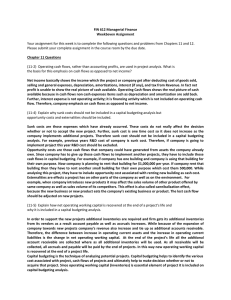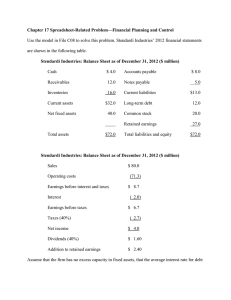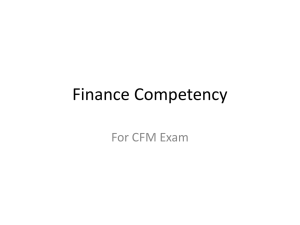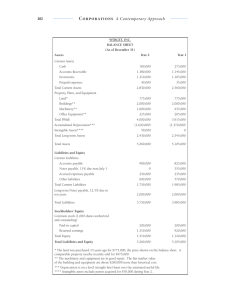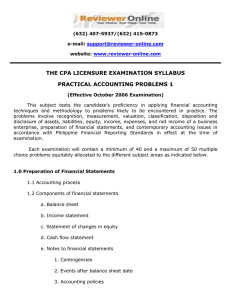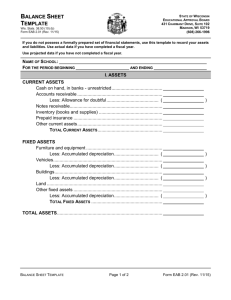Week 6 solutions
advertisement
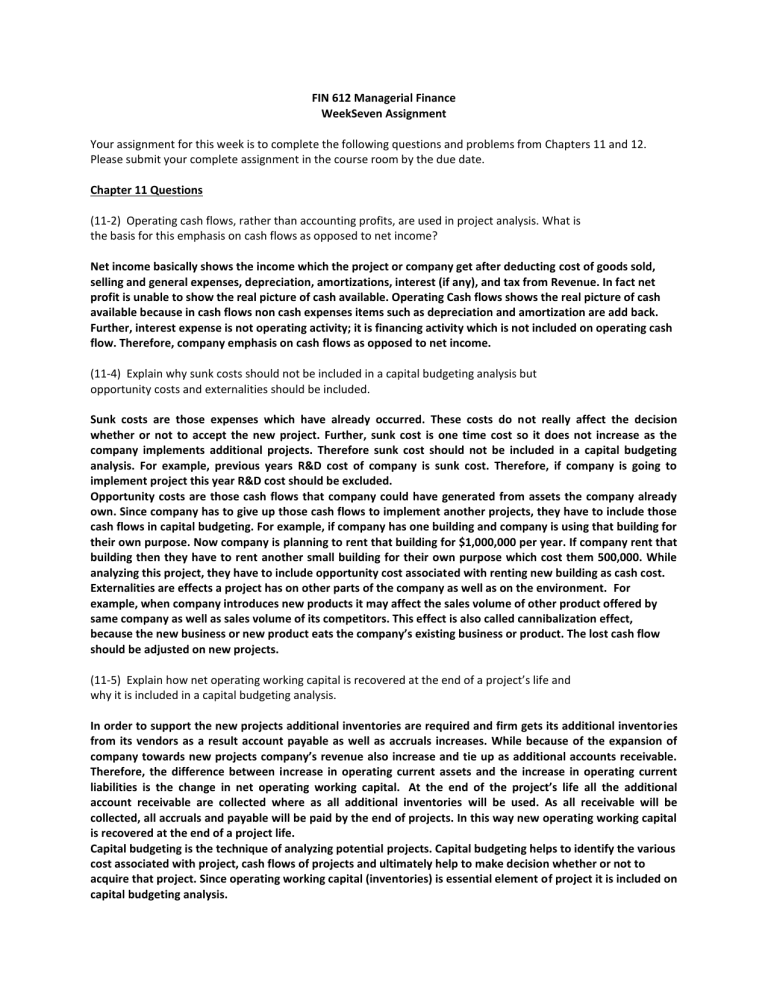
FIN 612 Managerial Finance WeekSeven Assignment Your assignment for this week is to complete the following questions and problems from Chapters 11 and 12. Please submit your complete assignment in the course room by the due date. Chapter 11 Questions (11-2) Operating cash flows, rather than accounting profits, are used in project analysis. What is the basis for this emphasis on cash flows as opposed to net income? Net income basically shows the income which the project or company get after deducting cost of goods sold, selling and general expenses, depreciation, amortizations, interest (if any), and tax from Revenue. In fact net profit is unable to show the real picture of cash available. Operating Cash flows shows the real picture of cash available because in cash flows non cash expenses items such as depreciation and amortization are add back. Further, interest expense is not operating activity; it is financing activity which is not included on operating cash flow. Therefore, company emphasis on cash flows as opposed to net income. (11-4) Explain why sunk costs should not be included in a capital budgeting analysis but opportunity costs and externalities should be included. Sunk costs are those expenses which have already occurred. These costs do not really affect the decision whether or not to accept the new project. Further, sunk cost is one time cost so it does not increase as the company implements additional projects. Therefore sunk cost should not be included in a capital budgeting analysis. For example, previous years R&D cost of company is sunk cost. Therefore, if company is going to implement project this year R&D cost should be excluded. Opportunity costs are those cash flows that company could have generated from assets the company already own. Since company has to give up those cash flows to implement another projects, they have to include those cash flows in capital budgeting. For example, if company has one building and company is using that building for their own purpose. Now company is planning to rent that building for $1,000,000 per year. If company rent that building then they have to rent another small building for their own purpose which cost them 500,000. While analyzing this project, they have to include opportunity cost associated with renting new building as cash cost. Externalities are effects a project has on other parts of the company as well as on the environment. For example, when company introduces new products it may affect the sales volume of other product offered by same company as well as sales volume of its competitors. This effect is also called cannibalization effect, because the new business or new product eats the company’s existing business or product. The lost cash flow should be adjusted on new projects. (11-5) Explain how net operating working capital is recovered at the end of a project’s life and why it is included in a capital budgeting analysis. In order to support the new projects additional inventories are required and firm gets its additional inventories from its vendors as a result account payable as well as accruals increases. While because of the expansion of company towards new projects company’s revenue also increase and tie up as additional accounts receivable. Therefore, the difference between increase in operating current assets and the increase in operating current liabilities is the change in net operating working capital. At the end of the project’s life all the additional account receivable are collected where as all additional inventories will be used. As all receivable will be collected, all accruals and payable will be paid by the end of projects. In this way new operating working capital is recovered at the end of a project life. Capital budgeting is the technique of analyzing potential projects. Capital budgeting helps to identify the various cost associated with project, cash flows of projects and ultimately help to make decision whether or not to acquire that project. Since operating working capital (inventories) is essential element of project it is included on capital budgeting analysis. (11-7) Why are interest charges not deducted when a project’s cash flows are calculated for use in a capital budgeting analysis? Interest charges are usually not deducted when project cash flows are calculated in capital budgeting because, it is best to separate investment decision from financing decisions. First you decide to invest or not, based on the operating cash flow generated discounted at the weighted cost of capital, which is based on a mix of debt and equity. Then you decide how to finance the project/s,. So, interest charges is not considered in the project cash flows. But interest cost is impliedly covered when the cash flows are discounted. (11-8) Most firms generate cash inflows every day, not just once at the end of the year. In capital budgeting, should we recognize this fact by estimating daily project cash flows and then using them in the analysis? If we do not, will this bias our results? If it does, would the NPV be biased up or down? Explain. Estimating Cash Flows on a daily basis would be too cumbersome and unwieldy. Estimating cash flows on an annual basis is good enough. No it would never bias the results. (11-11) In theory, market risk should be the only “relevant” risk. However, companies focus as much on stand-alone risk as on market risk. What are the reasons for the focus on standalone risk? Taking on a project with high degree of either stand-alone or corporate risk will not necessarily affect the firms beta. However, if the project has highly uncertain returns and if those returns are highly correlated with returns on firms other assets and with most other firms in the economy, the project will have a high degree of all types of risks. For example, General mortors undertake decides to undertake a major expansion to build commuter airlines. GM is not sure how its technology will work on a mass production basis, so there are great risks in the ventureits stand-alone risk is high. Management also estimates that the project will do best if the economy is strong, for then people will have more money to spend on the new planes. This means that the project will do well if GM's other division do well and tend to do badly if other division do badly. This being the case the project will also have a high corporate risk.Finally, GM's profits are highly correlated with those of most other firms, the projects beta will also be high. Thu, this project will be riskier under all three types of risks. Of the three, the market risk is theoretically the most relevant because it is one reflected in stock prices. Unfortunately, market risk is also the most difficult to estimate because projects dont have market prices that can be related to stock market returns. For this reason, most decision makers consider all three risk measures in a judgemental manner and then classify projects into subjective risk categories. Chapter 11Problems (11-3) Allen Air Lines must liquidate some equipment that is being replaced. The equipment originally cost $12 million, of which 75% has been depreciated. The used equipment can be sold today for $4 million, and its tax rate is 40%. What is the equipment’s after-tax net salvage value? Book Value = 12000000*(1-.75) = 3000000 Gain on Sale = 4000000 - 3000000 = 1000000 After Tax Net Salvage Value = 4000000 - (1000000)*.40 = 360000 (11-4) Although the Chen Company’s milling machine is old, it is still in relatively good working order and would last for another 10 years. It is inefficient compared to modern standards, though, and so the company is considering replacing it. The new milling machine, at a cost of $110,000 delivered and installed, would also last for 10 years and would produce after-tax cash flows (labor savings and depreciation tax savings) of $19,000 per year. It would have zero salvage value at the end of its life. The firm’s WACC is 10%, and its marginal tax rate is 35%. Should Chen buy the new machine? You need to calculate the NPV of the machine in this case NPV = -110000 + 19000/(1+.10)^1 + 19000/(1+.10)^2 + 19000/(1+.10)^3 + 19000/(1+.10)^4 + 19000/(1+.10)^5 + 19000/(1+.10)^6 + 19000/(1+.10)^7 + 19000/(1+.10)^8 + 19000/(1+.10)^9 + 19000/(1+.10)^10 = 6746.77 or 6747 Yes, Chen should buy the new machine. (11-6) The Campbell Company is considering adding a robotic paint sprayer to its production line. The sprayer’s base price is $1,080,000, and it would cost another $22,500 to install it. The machine falls into the MACRS 3-year class, and it would be sold after 3 years for $605,000. The MACRS rates for the first three years are 0.3333, 0.4445, and 0.1481. The machine would require an increase in net working capital (inventory) of $15,500. The sprayer would not change revenues, but it is expected to save the firm $380,000 per year in before-tax operating costs, mainly labor. Campbell’s marginal tax rate is 35%. Part A: 0 Year Net Cash Flow = -1080000-22500-15500 = -1118000 Part B: Annual Savings Less Depreciation Savings after Depreciation Less Taxes Savings after Taxes and Depreciation Add Depreciation Operating Cash Flow Year1 380000 367463 12537 4388 8149 367463 375612 Year2 380000 490061 -110061 -38521 -71540 490061 418521 Part C: Additional Cash Flow in Year 3 = 605000 + (605000 - 81695)*(.35) + 15500 = 803657 Year3 380000 163280 216720 75852 140868 163280 304148 Part D: To calculate IRR, you need to put the value of NPV as 0 and use following equation to derive IRR NPV = 0 = -1118000 + 375612/(1+r)^1 + 418521/(1+r)^2 + (304148 + 803657)/(1+r)^3 Solving for r, we get IRR as 25.87 or 26% Yes, the machine should be purchased. Chapter 12Problems (12-1) Broussard Skateboard’s sales are expected to increase by 15% from $8 million in 2013 to $9.2 million in 2014. Its assets totaled $5 million at the end of 2013. Broussard is already at full capacity, so its assets must grow at the same rate as projected sales. At the end of 2013, current liabilities were $1.4 million, consisting of $450,000 of accounts payable, $500,000 of notes payable, and $450,000 of accruals. The after-tax profit margin is forecasted to be 6%, and the forecasted payout ratio is 40%. Use the AFN equation to forecast Broussard’s additional funds needed for the coming year. AFN = $238,800 Sales expected in 2013 =$9,200,000 After-tax profit margin ($9,200,000*6%)=$552,000 Dividend payments [$552,000*40%]=$220,800 Addition to retained earnings [$552,000 - $220,800]=$331,200 All the profits after the payment of dividend will be an addition to retained earnings. As the assets are already at full capacity, all the assets should grow at the sales rate. It is to be noted that if the assets were not at full capacity, only the spontaneous assets would increase. Increase in assets = $5,000,000*15%=$750,000 Increase in liabilities = [$450,000+$450,000]*15%=$135,000 For current liabilities, only the accounts payable and accruals are treated as spontaneous liabilities. Notes payable is not considered spontaneous for AFN calculation. AFN = Increase in assets Increase in liabilities Addition to retained earnings $750,000 - $135,000 - $331,200=$283,800 ANSWER (12-8) Stevens Textiles’s 2013 financial statements are shown here: Balance Sheet as of December 31, 2013 (Thousands of Dollars) Cash $ 1,080 Accounts payable Receivables 6,480 Accruals 2,880 Inventories 9,000 Line of credit 0 Total current assets $16,560 Notes payable 2,100 Net fixed assets 12,600 Total current liabilities Mortgage bonds 3,500 Common stock 3,500 ______Retained earnings 12,860 Total assets $29,160 Total liabilities and equity $ 29,160 $ 4,320 $ 9,300 Income Statement for December 31, 2013 (Thousands of Dollars) Sales $36,000 Operating costs 32,440 Earnings before interest and taxes $ 3,560 Interest 460 Pre-tax earnings $ 3,100 Taxes (40%) 1,240 Net income $ 1,860 Dividends (45%) $ 837 Addition to retained earnings $ 1,023 a. Suppose 2014 sales are projected to increase by 15% over 2013 sales. Use the forecasted financial statement method to forecast a balance sheet and income statement for December 31, 2014. The interest rate on all debt is 10%, and cash earns no interest income. Assume that all additional debt in the form of a line of credit is added at the end of the year, which means that you should base the forecasted interest expense on the balance of debt at the beginning of the year. Use the forecasted income statement to determine the addition to retained earnings. Assume that the company was operating at full capacity in 2013, that it cannot sell off any of its fixed assets, and that any required financing will be borrowed as notes payable. Also, assume that assets, spontaneous liabilities, and operating costs are expected to increase by the same percentage as sales. Determine the additional funds needed. b. What is the resulting total forecasted amount of the line of credit? a. Stevens Textiles Pro Forma Income Statement December 31, 2014 2006 Forecast Basis Sales 36000 1.15 x Sales Operating Costs 32,440 .9011 x sales (07) EBIT 3,560 2007 41,400 37,306 4,094 Interest EBT Taxes (40%) Net Income Dividends Addition to RE 460 3,100 1,249 1,860 837 1,023 Stevens Textiles Pro Forma Balance Sheet December 31, 2014 (Thousands of Dollars) Forecast Basis % 2006 2007 Sales Cash 10,800 .0300 Acc. Rec. 6480 .1883 Inventories 9000 .2005 Total Curr. 16560 Assets Fixed Assets 12600 .3500 Total Assets 29160 Acc. Payable 4320 .1200 Accruals 2880 .0800 Notes 2100 Payable Total Curr. 9300 Liablities Long-term 3500 debt Total Debt 12800 Common 3500 Stock Retained 12860 Earnings Total 29160 Liablities and Eq. AFN = 2128 b. Notes payable: $4228 .1 x Debt (06) Additions Pro Forma 1,242 7452 10350 19044 14490 33534 4968 3312 2100 1.166* 560 35,34 1,414 2,120 954 1,166 Financing +2128 Pro Forma after Financing 1242 7452 10350 19044 14490 33534 4968 3312 4228 10380 12508 3500 3500 13880 3500 16008 3500 14026 14026 31406 33534
